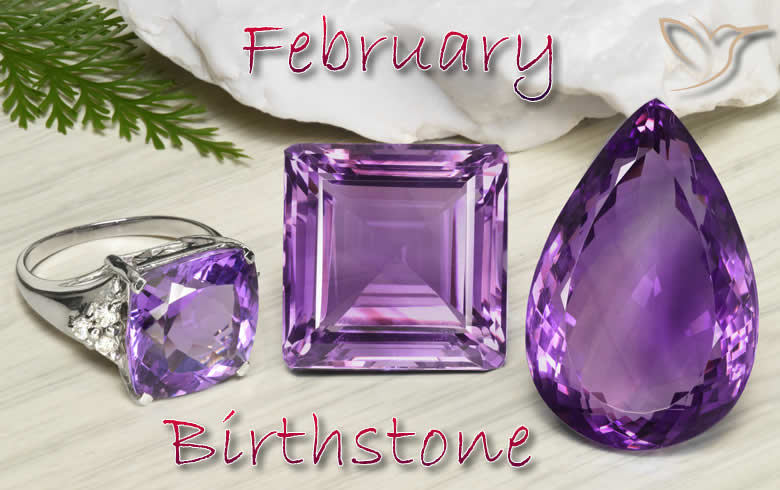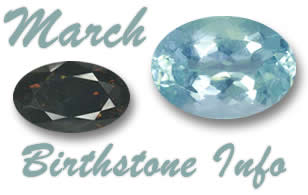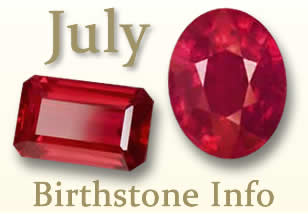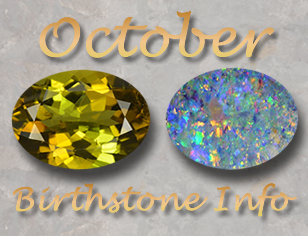What can I find in this article?
- What is the color of the February birthstone?
- The Etymology, History and Lore of Amethyst
- What is the spiritual meaning of amethyst?
- Healing Properties and Health Benefits of Amethyst
- What is the durability of the amethyst?
- Cleaning and Caring for Amethyst
- How much do amethysts cost?
- Are there any secondary February birthstones?
- Final Thoughts
The February Birthstone - Amethyst

There is really no question in people's minds when it comes to the February birthstone - it is most decidedly amethyst, a gemstone synonymous with purple. This variety of quartz was once highly prized and often valued above ruby and emerald. In fact, amethyst was known in the ancient world as one of the five cardinal gemstones: diamond, emerald, ruby, sapphire, and amethyst. During the 19th century, large amethyst deposits were found in Brazil and continue to produce an abundance of gemstone quality amethyst today.
Though this supply has decreased the price of amethyst, it has not diminished its beauty, and amethyst remains the most sought after variety of quartz. It has broad appeal due to its color range, and its durability makes it an excellent choice for February birthstone jewelry and ornaments.
Like many of the most well-known gemstones, amethyst's name is used to refer to a specific color frequency between purple and violet. There is more to this February birthstone's color palette, though. The hue (all the colors on the color wheel) and tone (lightness or darkness of the hue) of amethyst vary quite a bit, actually. It can range primarily from a light pinkish violet to a deep purple, with hues of red and blue sometimes occurring, as well.
These colors can be so light and subtle that they are nearly indistinguishable, or so dark that they make the gemstone opaque. The lighter toned amethysts make their way to commercial production of jewelry for the mass market, while the premium reddish purple color is reserved for high-end, designer jewelry. 'Siberian amethyst', a deep purple color variety with red and blue flashes, commands the highest price on the market.
Many creative descriptions are used to animate the amethyst's field of color:
- 'Orchid' and 'lavender' for lighter tones
-

- 'Grape', 'indigo', or 'royal' for darker colors
-

- 'Raspberry' or 'plum' for reddish colors
-

Amethyst commonly exhibits what is called 'color zoning', when the saturation of the purple varies throughout the gemstone.
One of the many skills a lapidary (person who cuts gemstones) must have when working with amethyst is to know how to cut the stone so that the finished product has a homogenous color. If the amethyst has a highly distinct color zone, it may be cut in such a way that features the color zone, rather than avoiding it.
Amethyst can also be dichroic (it shows two different colors when observed in different light or from different angles) in reddish violet or bluish violet amethysts.
When heated, amethyst turns yellow-brown, yellow-orange, or dark-brownish. Incidentally, Brazilian amethyst is often heat-treated to create citrine, and ametrine (a mix of amethyst and citrine with purple and yellow or orange color zones) when partially heated.
Amethyst gets its name from the Greek amethystos, meaning 'not drunk or intoxicated'. The Greeks named this gemstone in the age-old belief that wearing it, or drinking from a cup carved from it, would protect one from becoming drunk, or act as an antidote to intoxication, possibly due to amethyst's color resembling that of wine.
One of the myths surrounding amethyst relates to the Greek god of winemaking, Dionysus (known as Bacchus in Roman mythology) who had suffered an insult from a mortal. In his rage, he swore to slay the next mortal who crossed his path with a pack of savage tigers of his creation. Tragically, that moratal was Amethystos, a beautiful young maiden on her way to pay tribute to Artemis, goddess of the hunt, the wilderness, wild animals, the Moon, and chastity. Artemis took pity on Amethystos, her loyal devotee, and turned her into a statue of pure crystalline quartz to protect her from the ripping claws of Dionysus' tigers. After beholding the statue for himself, Dionysus wept tears of wine, staining the quarts, thus giving amethyst its characteristic purple color.
In addition to the belief that amethyst could prevent or cure intoxication, it was also thought to keep its owner clear-headed and quick-witted in business and battle, prompting medieval European soldiers to wear the February birthstone as a protective amulet.
Amethyst has been considered the February birthstone since the Roman period when it was associated with Neptune, as well as St. Valentine, the 3rd century saint and paragon of courtly love, who was thought to wear an amethyst ring inscribed with the image of Cupid.
In the Christian tradition, the February birthstone (and the color purple) came to symbolize royalty and the clergy, particularly the bishops, who wore amethysts in ecclesiastical rings for protection from mystical intoxication. Moreover, amethysts were known to adorn the wine goblets of the clergy and nobility alike, in order to guard them from the more common alcoholic intoxication.
The ancient Hebrews knew the amethyst as ahlamah, the ninth of twelve gemstones used to represent the tribes of Israel on the breastplate of Aaron, high priest of the Israelites and brother to Moses. It is believed that the February birthstone signified the Tribe of Dan, known as Judges.
To the Egyptians, amethyst was known as hemag, and it was listed in the Book of the Dead to be carved into heart-shaped amulets and placed inside burial tombs. In eastern philosophies, the amethyst has long been used in temple offerings and to create beaded prayer rosaries. Still to this day, the Tibetans hold amethyst as sacred to the Buddha and carve their prayer beads from it.
Since antiquity, the February birthstone has been known to heighten virtues such as chastity, sobriety, and control over one's thoughts. Amethyst's ability to prevent the anger of passion and the violence of base actions by encouraging calm, bravery and contemplation, has given it a place of esteem from the Old World to the current age.
Today, the most important amethyst deposits are found in Brazil and Uruguay and the majority of the world's supply is sourced from those mines.
Other locations for top commercial producers of amethyst include Bolivia, Tanzania, and Zambia, but February birthstones can be found all over the world. Amethyst occurs in many localities in the United States, including Arizona, Texas, Pennsylvania and Michigan; however, the largest amethyst mine in North America is in Thunder Bay, Ontario.
If we begin with amethyst's most characteristic color - purple - we will find connections to mystery, magic, power, and luxury. Purple contains the energy and strength of red, as well as the spirituality and integrity of blue; it symbolizes the union of body and soul, creating a balance of our physical and spiritual beings.
Amethyst is the birthstone for both Aquarius (February 1 -18) and Pisces (19 - 28).
These two signs encompass personality traits that vary from charm and adventurousness, to artistry, sensitivity and deep love. It is no surprise, then, that the February birthstone embodies these spiritual virtues, as well.
The blue and purple shades of amethyst tie it directly to the higher chakras - the throat chakra (blue), the third-eye chakra (indigo) and crown chakra (violet).
These energy nodes are the seats of communication, wisdom, and spiritual connection, respectively. The February birthstone stimulates the higher mind to receive spiritual power as a creation of the divine being, and opens one to the insights, wisdom, and guidance that flow from that power.
Finally, the February birthstone has a connection to the sacred institution of marriage.
Amethyst is given on the 6th wedding anniversary.
Numerologists speak of a six-year cycle of life, during which time occur different phases of growth and change. The sixth year emphasizes love and matters of the heart, particularly to do with marriage, family, and children.
As was well-known in the Old World, amethyst has the ability to prevent or cure intoxication. In ancient times, such intoxication was mainly due to alcoholic drinks. Today, intoxication and addiction run the gamut of toxic substances. In addition to treating alcoholism, the February birthstone is useful in treating addiction to opioids, amphetamines, and tobacco. Moreover, it can help calm the temperament of a person who finds themselves addicted to gambling, 'adrenaline sports', and sex.
Often called 'nature's tranquilizer', amethyst can soothe the mind of hyperactive children and those suffering from obsessive compulsive disorders. The February birthstone can also cure insomnia and encourage pleasant dreams.
Regarding the physical body, the February birthstone optimizes the endocrine glands and their production of hormones, while stimulating the sympathetic nervous system (the 'fight-or-flight' response), as well. Amethyst also strengthens the immune system, supports oxygenation of the blood, reduces inflammation and related conditions (arthritis, especially), and aids in the treatment of the heart, digestive system, and skin.
The February birthstone is also used to treat and cure ailments of the ethereal body. It offers psychic healing and protection of the energy field that exists around every being. Amethyst does this spiritual cleansing and removes the darkness, while leaving a shield of positivity and light in its place.
Imbalance and disease are not only caused by environmental factors, but they are provoked by one's negative thoughts and emotional patterns. The February birthstone is useful in the identification of these damaging mental pathogens.
Amethyst's connection to the higher self of wisdom and spiritual understanding, make it an excellent healing crystal for those who are grieving the loss of a loved one. The February birthstone encourages the release of sorrow by empowering one to understand that death is merely a transition of the spirit, now free from the physical body.

The concept of durability is comprised of three factors: hardness (resistance to scratching), toughness (resistance to chipping, cracking and breakage), and stability (resistance to chemicals, high temperatures, and light).
As a variety of quartz, amethyst is considered a hard gemstone. It has a rating of 7 out of 10 on the Mohs hardness scale, ten being the hardest (diamond).
Gemstone hardness explained, read our complete article here.
This is an important distinction because only gemstones and other materials higher than 7 can scratch amethyst. As quartz is everywere - even airborne in dust - it poses a threat to softer gems that need special care.
Amethyst has a good toughness and is very stable, although it should not be subjected to rapid changes in temperature, which can cause fractures; or prolonged exposure to intense light, which can cause colors to fade. Moreover, it can be damaged by alkaline solutions, like bleach and metal polishes; hydrofluoric acid, a chemical found in rust removers; and ammonium fluoride, found in laundry detergents, spot removers and de-greasers.
Amethyst is considered a durable gemstone that is appropriate for all styles of jewelry - rings, bracelets, necklaces and earrings are all safe for February birthstones.
As with all jewelry, especially crystals like amethyst, it is important to remember that they can chip or break; so, it is recommended to take proper care when wearing or cleaning them.
The February birthstone is safely, simply, and effectively cleaned with warm soapy water and a soft brush, such as a toothbrush. Ultrasonic cleaners may be used to clean amethyst, except in the very rare case that it has been dyed or fracture-filled. Be aware: ultrasonic cleaners can not only cause and exacerbate fractures in gemstones, they can loosen jewelry and cause gems to fall out of their settings. Steam cleaners should not be used to clean amethyst because it should not be subjected to high temperatures.
Amethyst is durable enough to survive the odd bump or knock on a hard surface; however, you should always take care to avoid such abuse. That is why it is always recommended to remove jewelry before physical activities, especially household cleaning or gardening.
Due to amethyst's hardness, it is important to protect softer stones from being scratched. Similarly, you will want to prevent scratches to your February birthstone from harder gems (sapphire, diamonds, etc.). Therefore, it is imperative to keep your amethyst separate from all other gems of different hardness in a fabric-lined compartment of a jewelry box. Individual cloth jewelry bags are also suitable if you have limited space in your box.
Another space-saving method is to use acid-free paper envelopes, called 'parcel paper envelopes' or 'diamond papers', to keep gemstones of the same hardness together and arranged in a parcel paper organizer box. Glass jars with foam or fabric inserts are perfect for those who want to showcase their loose gemstones and jewelry.

Amethyst is available in just about every shape, cut and size, though it is more often faceted than left as a cabochon since it has good clarity in rough form. Calibrated sizes are easily found and fancy shapes such as trillions, hearts and shields are very common. Many artisans prefer to cut ornamental carvings with amethyst stone; so, it is very common to find such pieces on the market today.
The February birthstone is commonly found in faceted rounds and ovals, and the prices do not tend to climb exponentially above 1 carat, as with many precious gemstones. In fact, an 81 carat, oval checkerboard, is just under $500. Those looking for smaller sizes, can find a 24 carat, octagonal step cut, sized about 16 x 15 mm for $150.
Amethyst offer a vibrant choice for birthstone earrings. A pair of 3.6 carat, pear facet amethyst is only $50. If a February birthday gift is to be a necklace or bracelet, lots of amethyst in smaller sizes are easily available. A 15 piece set of 0.6 carat, trillion facet, sized about 7 x 6mm, can be yours for $60.
Amethyst geodes are popular home decorations, and would perfectly suit the household of an Aquarius or Pisces.
An 80 carat, fancy crystal cluster amethyst geode, is a fun way to say 'happy birthday,' for just around $80.
Prior to the 1912 Jewelers of America list of birthstones, hyacinth (the old world name for zircon) and pearl were considered February birthstones, in addition to amethyst. Today, amethyst is widely accepted as the primary and exclusive birthstone for this month. Those who were born in the Aquarius zone of this month, may adopt the garnet as their birthstone.
February is a month that symbolizes the second step into a new year and all the energy and excitement that comes from change and growth. Amethyst calms an active mind, cleanses the body and spirit, and connects us with our higher selves.
As a durable form of quartz, this soothing gemstone, in all its splendor and charm, is an outstanding choice for February birthstone jewelry. Amethyst is abundant, but only the best quality will do. Always seek reputable gemstone dealers like Gemselect to ensure you get the very best birthstones at the most competitive prices.
Disclaimer
Disclaimer GemSelect has been buying and selling gemstones for many years now and in that time we have built up quite a relationship with our customers and suppliers. We are not experts in the meanings and health benefits of gemstones but we have been able to speak with and take advice from people who are.
We are based in Thailand where the belief in spiritual and physical benefits of gemstones, herbs, prayers, pilgrimages, amulets, colors and the stars is common and part of nearly everyone's daily life.
All of our employees have some experience with using gemstones or amulets in order to improve or maintain their physical or emotional health.
The powers of gemstones have been chronicled for 1000s of years and proven time and time again to be effective in improving people lives in many, many ways but we must stress that they are not a replacement for medical treatment.
If you feel unwell or are concerned about your mental health please contact qualified medical help as soon as you can.
In addition we try to research and verify information about the history and efficacy of each gemstone using the internet and various reputable books published by a number of sources.
- العربية | حجر بخت شهر فبراير: أكثر من مجرد حجر أرجواني
- 中文 | 二月生日石:不仅仅是一颗紫色宝石
- Français | Pierre de naissance de février : plus qu'une simple pierre vio...
- Deutsch | Geburtsstein Februar: Mehr als nur ein violetter Stein
- Italiano | Febbraio Birthstone: più di una semplice pietra viola
- 日本語 | 2月の誕生石:単なる紫色の石ではありません
- 한국인 | 2월 탄생석: 단순한 보라색 돌 그 이상
- Português | Pedra de nascimento de fevereiro: mais do que apenas uma pedra roxa
- Pусский | Камень февраля: больше, чем просто фиолетовый камень
- Español | Piedra natal de febrero: más que una piedra morada
















